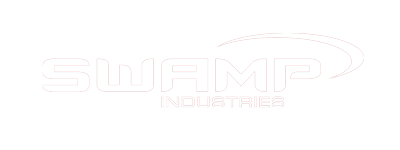Podcast Recording Guide - Tips for Great Sounding Audio
Author: Tom Graham
Posted: 13 September 2020Comments: 1 [Post]
Synopsis: Thinking of starting a podcast but don’t know where to start with your audio? We have put together information to guide you through the process of choosing right microphone, mixing console / audio interface including doing mix minus for phone callers.

Choosing the right microphone for your podcast
First thing to consider is the number of people involved in your podcast and the location or setting that recording will take place. Depending on your requirements and budget you may elect to use multiple microphones, or microphones with pickup patterns that allow a microphone to be shared. The location is also important due to the fact that some microphones are more sensitive than others and background noise can be an issue for some settings.
Solo Podcaster
If there was a scale of complexity for the audio setup of a podcast then the setup for solo podcaster would be at the simple end of scale. A single uni-directional microphone is needed along with the ability to monitor the sound through headphones. A condenser microphone with a large diaphragm is the best choice for recording voice in a quiet location, as they record sound with warmth, detail and clarity and pick up a wider frequency range compared to dynamic microphones. If your location is subject to issues from outside noise, dynamic microphones or small diaphragm condenser microphones (such as clip-on lapel microphones) may be a better option, as these microphones are less sensitive
A USB condenser microphone that has a headphone output is an ideal all-in-one solution for the solo podcaster. The USB connection means no external audio interface is required, and most have plug and play capability with any audio recording software on MAC or PC. A headphone output also allows for playback or monitoring of audio from a computer, say to hear audio from an interviewee from Skype or Zoom.
In regards to the polar pattern / pickup pattern, the solo podcaster only needs a unidirectional microphone also known as a cardioid mic. All this means is that sound is picked up by the mic in an area 180° directly in front of the microphone, rather than 360° for an omni pattern mic.
One of the most popular microphones on the market for podcaster’s, the Yeti by Blue Microphones, is a USB condenser microphone that has most of the above features. Our very own SWAMP SU600 also matches the requirements for a solo podcaster perfectly, and records at 24-bit 96KHz. While the Alctron BC800V2 is an ideal broadcast style dynamic microphone.
Also just consider grabbing a pop filter for your using a consider mic setup close to person's mouth. Foam wind socks also assist with blocking sounds caused by rushes of air andwith most people only talking during podcasts, these foam wind shields are genereally all you need.
Podcasts with Live Interviews
If you have multiple people in the room, microphone selection becomes more important. A broadcast style dynamic microphone is the ideal option if you have multiple interviewees or issues external noise, though those with the luxury of soundproofed studios and are recording only themselves or 1 other person, will find condenser mics can offer a superior sound that can be more finely tuned in post production.
Condenser Mics for Podcasts
Using condenser microphones with omni-directional (360 degree) or bi-directional (figure 8) pickup patterns, allows for recording 2 or more people at once. If you record using a single microphone the most important thing is to ensure everyone will be picked up by the mic clearly and evenly. It is much easier to get the recording balance right in the first place rather than trying to fix the problem with digital editing later on!
If you’re conducting live interviews, it is a good idea to just start with two microphones, one for yourself and one for your interviewees. We’d recommend a broadcast style dynamic microphone for yourself, and a condenser mic with an omni-directional pick up option for your guests. Ideally, you would then record each microphone to a separate audio track, enabling for easy post production to even out levels and apply some EQ and compression for each voice.
There might be times when using the standard large diaphragm condenser microphones won’t work for you. Say it may not be possible to drop an omni-directional condenser microphone evenly on the table to capture all of the interviewees, or your home studio is close to a busy roadway and the traffic can invade your recordings. In the situation of having a large number of interviewees and the need to be able to record each voice to a separate audio track, then a clip on lapel / lavilier microphones with optional wireless transmission systems can be a good option. Lapel microphones are ‘mini diaphragm’ condenser microphones and have a strong pickup range for their size, but won’t pick up sounds over many meters like a large diaphragm condenser mic.
Broadcast Type Dynamics Mics
A broadcast style dynamic microphone is often the best option for podcasts as this type of microphone requires the sound source to be relatively close to the microphone and won’t pick up sounds from all over the room. Though a broadcast style dynamic mic is more sensitive than a typical vocal type dynamic mic. The downside compared to condenser mics can be extra cost associated with having a more expensive mic for each interviewee.
Dynamic microphones are great if you have issues with bleed (noise from external sources getting in the wrong microphone). They are not nearly as sensitive, meaning outside traffic and internal room noise won’t likely be an issue. One small problem is that you need better “mic technique” to ensure an even volume during recording. This just means talking directly into the microphone and not turning your head too much. Therefore room setup and mic placement should be considered so people can see each other easily.
In a podcast situation getting the mic that close at all times isn’t always possible, as there is a high likelihood that people are going to move their head around. To compensate for this again for the mic gain needs to be increased (making it more sensitive), though the user still needs to be mindful of keeping an even distance from the microphone throughout the podcast, as any differences in the proximity to the microphone will be noticeable compared to say a condenser microphone. If you do encounter a guest that moves around a lot, post production compression can greatly assist in resolving volume differences throughout a recording. So if you are on a budget, you can simply pull out your SM58 or similar vocal mics and get decent results.
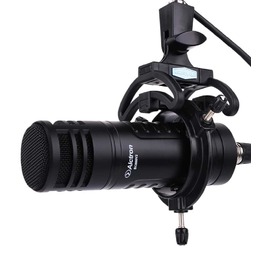 |
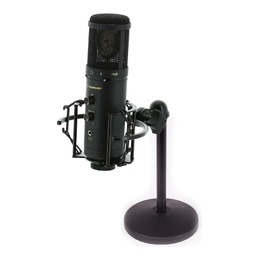 |
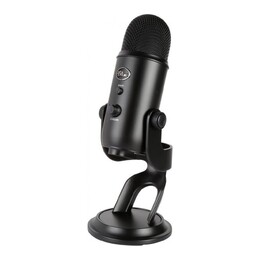 |
Room Acoustics
If you find your recordings are not sounding crisp and professional, it would be logical to assume that there’s something wrong in the signal chain, maybe distance from the mic, mic choice, cabling, or computer software. However, one of the main contributors to bad podcast audio that is often ignored is the room in which the recording takes place, or more specifically, room acoustics. To understand room acoustics and how to manage and manipulate them, we must revisit some basic physics, but don't stop reading! It’s actually quite simple.
Imagine you throw a stone into a large pond on a still day. You’ll notice the ripples from the splash spread out evenly in a circle and travel uninterrupted until you can’t see them any more. Now imagine the water has settled and you throw in three stones instead of one. The water is this time more disturbed and the ripples travel through each other creating little waves and peaks. Finally, imagine that instead of a large pond, you throw some stones into a backyard pool. The waves spread out, but once they reach the edge of the pool wall, they don’t stop, but bounce back from the direction they came, and continue to bounce around crashing into each other and making the surface of the water very choppy. Starting to make sense?
Sound from your guest’s and your voices behaves just like the ripples in the pool, except the waves travel through the air, in three dimensions, and you can’t see them… This might seem complicated, but the general takeaway is that if you have too many sounds interacting in a small room with reflective walls, the “air” becomes full of interacting ways and it becomes very hard for the microphone, no matter how expensive it is, to “hear” a clear sound, so the result ends up sounding “echo-y” or “tinny”. The solve these problems, rooms can be treated, with absorption or diffusion.
Acoustic treatmeant or sound absorbers, often made from high density foam or fibreglass, improve the “sound” of a room by preventing sound waves from bouncing off the surfaces they are applied to, and so getting back the microphone and interrupting the original sound. However, too much absorption can make a room sound lifeless and uncomfortable. This is where diffusion comes in. Diffusers, often made from timber or hard polymers break up and spread out sound waves in a targeted way. Creating more reflections might sound counterintuitive, but go back to the water analogy; lots of tiny waves won’t rock a boat, but a few large waves will! If you can’t treat the reflective surfaces themselves, it is possible to “protect” your mic from invasive reflections with a reflection filter, which acts as a barrier to unwanted reflections.
One can’t control the acoustics of a space with a single simple solution, especially on a budget. However, by acknowledging the principles laid out above, applying a little absorption and/or diffusion and thinking about mic choice and technique, you can greatly improve the quality of your recordings.
 |
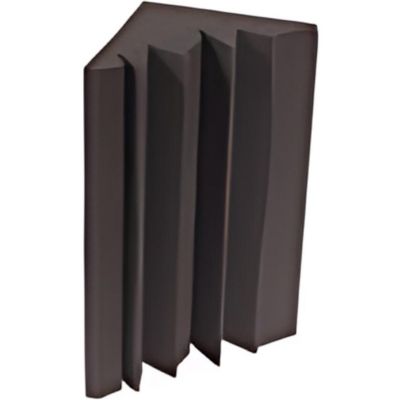 |
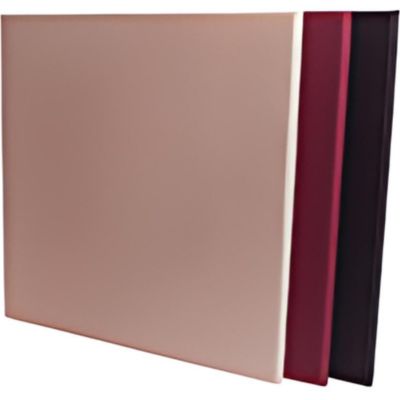 |
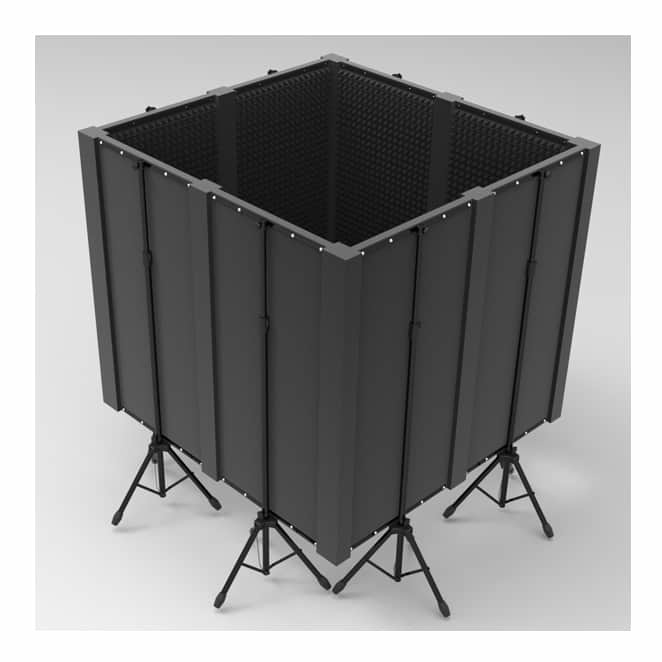 |
Mixing Consoles and Post Production
The solo podcaster has the simple option of using a USB microphone to connect to a computer for recording (USB mics contain a built-in audio interface). Any mics with an XLR (3pin) cable output, whether dynamic or condenser, will require an input on a mixer or audio interface that then connects to a computer. Consideration needs to be made on whether you want to record each microphone to a separate track in your recording software, which allows for more options when mixing in post production. Or whether mixing the tracks on the mixer itself is OK and just record the main outputs of the mixer. The multi-track recording option does increase the cost of the required audio interface.
2 Channel Mixing Desks
Mixing desks or audio interfaces that claim a 2 channel recording output, can record 2 channels or ‘left and right’ audio channels to a computer when recording. The SWAMP SM11 mini mixer with 1 mic input is ideal for a single mic and will record to both left and right channels. While the ICM UM-66 with 2 mic inputs and pan controls is ideal for recording two microphones to separate channels. Using the “panning” option, you can pan mics either all the way left or right, to then only record channels to the left or right track in your software.
Larger mixers with 2ch USB recording such as the SWAMP S8, allow for up to 4 microphones to be mixed together for recording and multiple stereo line inputs to connect a phone callers or sound source. Featuring AUX outputs,you can use these to achieve a ‘Mix Minus’ setup where the phone caller does not hear themselves, but can hear everything else on the mixer.
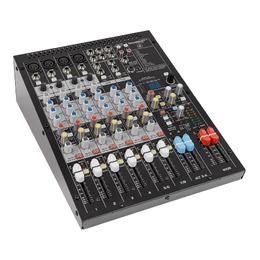 |
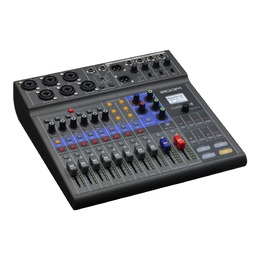 |
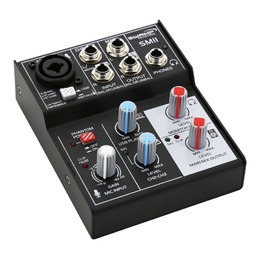 |
Multi-Track Recording Consoles and Interfaces
For podcasts involving more than 2 microphones that need to be separately recorded to your DAW software, a multi-track console or interface is required. The nature of the hardware involved for multi-track AD conversion means the costs jump up quite a bit. Though many options also bring on board extra features that can help take your podcast to the next level.
The Zoom L8 is an ideal podcasting mixer and multi-track audio interface packed with features. 6 mic or line inputs and a handy TRRS input/output on channels ⅞, that includes built-in Mix Minus capability. Designed to connect a smartphone to bring the callers audio into the mixer while also sending a mix of audio back to the caller that does not include their own voice. The L8 can also be battery powered and recorded to an SD card for portable and remote podcast recording. Multiple headphone outputs and not to mention onboard digital compression, EQ and routing make this an ideal option for the serious podcaster.
Mix Minus
The mix minus feature built into the Zoom L8 can also be easily achieved by using an AUX send (auxiliary output) on a mixer such as the SWAMP S8. For a caller via smartphone you could route the phone's audio output into say channels ⅞, and then use the AUX1 output to route audio from the mixer back to input of the phone. This routing can be achieved using a TRRS splitter cable and AUX cables. Lastly, turn down the AUX1 send control knob for channels ⅞ so they don’t hear themselves, while turning up other channels appropriately to give the caller an even mix of everything else. Best to use the ‘post’ fader option for the AUX channel so any changes on the main faders affect both the main output and the AUX sends. That way you can set your AUX send volumes evenly and just adjust the main faders as you do for the main mix.
Post Production and DAW Software
While you can still achieve great results producing a podcast recording on the fly without the need for post production mixing and editing. This usually requires more expensive hardware such as the Zoom L8 that has onboard compression and EQ, and a lot of time setting things up and getting microphone placements just right. If you are not live streaming your podcast, then taking some time to do post production work can be easier than you think can bring great results. There are plently of affordable audio mixing software applications out there including the free Audacity and options like Adobe Audition that you may already have. Consider Reaper, FL studio or Pro Tools if you want a fully functional professional level DAW that you grow with and learn over time.
EQ and Compression
If you recorded each person to separate channels on your audio recording software, then it becomes possible to easily use mixing tools to improve the sound quality of each recording. The use of equalisation (EQ) and compression should be front of mind, enabling you to improve clarity and evenness of sound without much effort. Considering saving settings in the software for easy recall and a good starting point when mixing a new recording.
Related Products
Comments (1)
Want to learn
30 October 2020Hi do you have pay plans and training for your equipment or short course?
SWAMP Industries Response
We do not have short course for podcasting at present, however we are planning on doing some videos using some our podcasting gear, to explain how to setup and use different types of equipment. Please message us via the live chat or contact us page and let us know more about your situation and what you are wanting to achieve, and we can always help that way and may use that as inspiration for topics to cover in our first videos.























